Along the foothills of Bhutan, the residents of Aangrajuli, a Bodo village have traditionally been hosting Kurmas or hill brothers over a century. The Kurmas, who, come down from the Himalayan Kingdom for different purposes, enjoy the warmth of hospitality of Indian villagers if a situation or necessity arises to stay in the village for the night or for longer period.
Connecting hearts to hearts between two countries, this village along the India-Bhutan international border of Udalguri district of Bodoland Territorial Region in Assam that forms part of Manas Landscape has acquired a unique reputation of offering hospitality and home space for Kurmas.
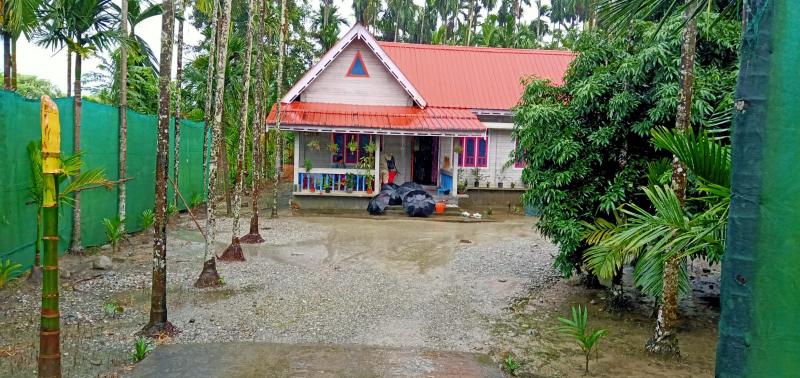
A homestay in Aangrajul village, Photo-Ratna Bharali Talukdar
Kurma is the honorific used by Indian border villagers for Bhutanese people who used to come down and stay and embodies a special relationship of bonding among people of Bhutan and indigenous Bodo people and other communities in the plains of Assam.
Due to improved connectivity between India and Bhutan, the Bhutanese people no longer require to stay for the night in these villages in BTR as they can return the same day.
However, when a section of youth of the village came forward with the idea to use such hospitality experience and skill into income generating activities in the form of home stay facilities, the villagers were initially confused. It took them some time to understand the idea of offering hospitality for an earning.
A homestay in Bhuyapara Rrange of MNP, Photo- Tonoy Protim Neog
Angrajuli is known for its picturesque beauty with lush green patches of trees and natural vegetation, vast paddy fields, and the village landscape is also dotted household areca-nut gardens. Gurgling waters of a beautiful Dong (a man-made stream created by making water diversion from river Dhansiri to use as irrigation canal) that feeds water to several villages downstream make the landscape perfect for nature photography. Bubbling freshwater springs, locally called as Bhumuks, at multiple locations along the Dong is a treat for the eyes of the visitors.
Didom Daimary, a nature enthusiast and field coordinator of Aaranyak, a research based nature organisation, however assured them with the hope that practically without investing anything, the villagers can earn, sitting at home by just keeping guests.
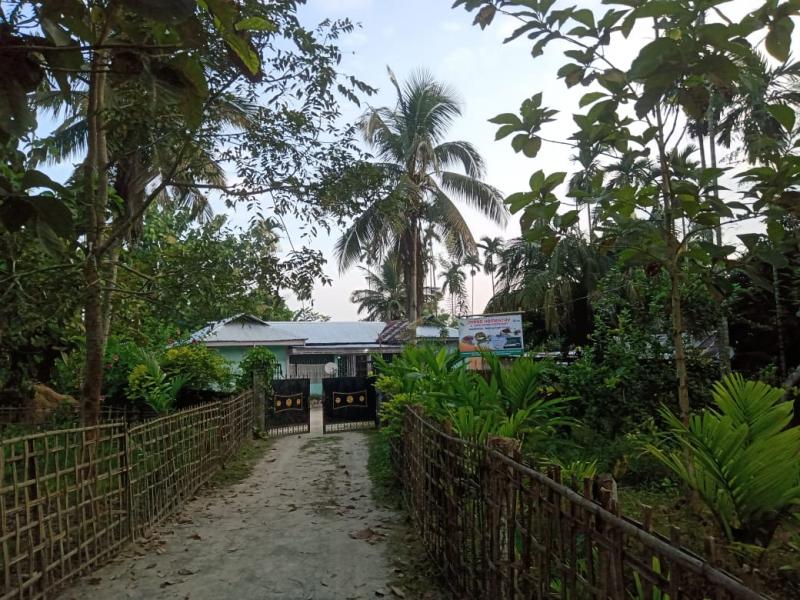
A homestay in Barking Ingti village, Photo-Sushanta Talukdar
“For ten years, we have also been growing a forest titled Sikaridanga man-made forest in a degraded plot of land covering a vast area of 600 acre under Joint Forest Management Committee (JFMC) model. The forest, with its thick bio-diversity provides shelter to large number of faunal resource like elephants, leopard, Bengal Florican. It also draws large number of nature lovers. The idea of developing homestays in our village came to my mind when a section of these tourists asked for accommodation facilities. Their queries gave me a new idea of developing homestay facilities in our village’’ says Didom.
However, he did not have any idea of how to make a start. Then, Aaranyak came forward to translate the idea with proper guidance and support, says Didom. A morning village tour and walk up to India-Bhutan international border pillar in early morning is a part a package they offer to their guests. The foothill plains in the backdrop of enchanting Bhutan hills, paddy-fields, greeneries of individual household campus are real treasure trove for villagers. A breakfast with traditional Bodo cuisines is followed by this morning tour.
The magical component of the package is a tour to Sikaridanga Man Made forest.
Homestay facilities that have come up in villages under Bhuyanpara range of Manas National Park host special guests like students and researchers apart from nature lovers.
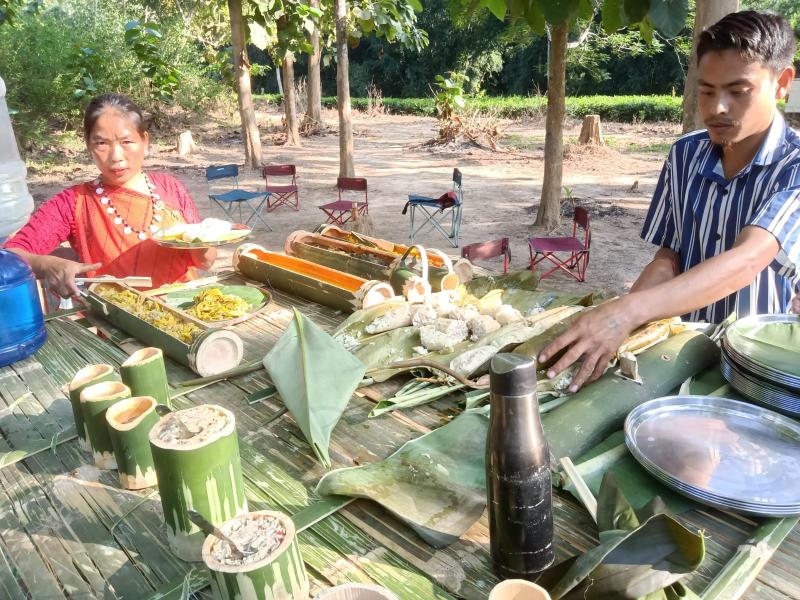
Traditional Karbi dishes offered to guests during Ingnam Kengkam ( Photo- Sushanta Talukdar)
Sonaiswari Basumatari in Majrapara village of the range hosted a student from Germany for six long months, who studied available fuel-wood in homestead land as part of her Masters internship. It was a pleasant experience for her to host a guest from a foreign country for such a long time.
Over the long duration of stay, the guest from an unknown place became like a family member. At the time of departure, her parent too visited her place.
Owners of homestays of Angrajuli village holding consultation with resource persons of Aaranyak,
Photo- Tonoy Protim Neog
“During her long stay in our village, the German student visited almost all of our relatives. She also used to wear traditional Bodo attire, participated in all the religious functions and festivals. She became a part of our family. She was an ardent lover of traditional Bodo cuisine” Sonaiswari Basumatari recollects.
For Hala Mochahari of the village, a farmer and also having expertise in masonry work, developing homestay facilities as income generating activities was a necessity, as some guests of Aaranyak intended to stay in their locality for study and research purposes.
Hala Mochahari loves to serve his guests with home grown rice and vegetables, eggs of his own poultry, and fish from his own pond. His guests are mostly students, and come through Aarnyak link. He has fond memories of hosting a student from Africa, one of lady from Jamnagar, a city in Gujarat and a student from Tata Institute of Social Sciences, Guwahati for long period.
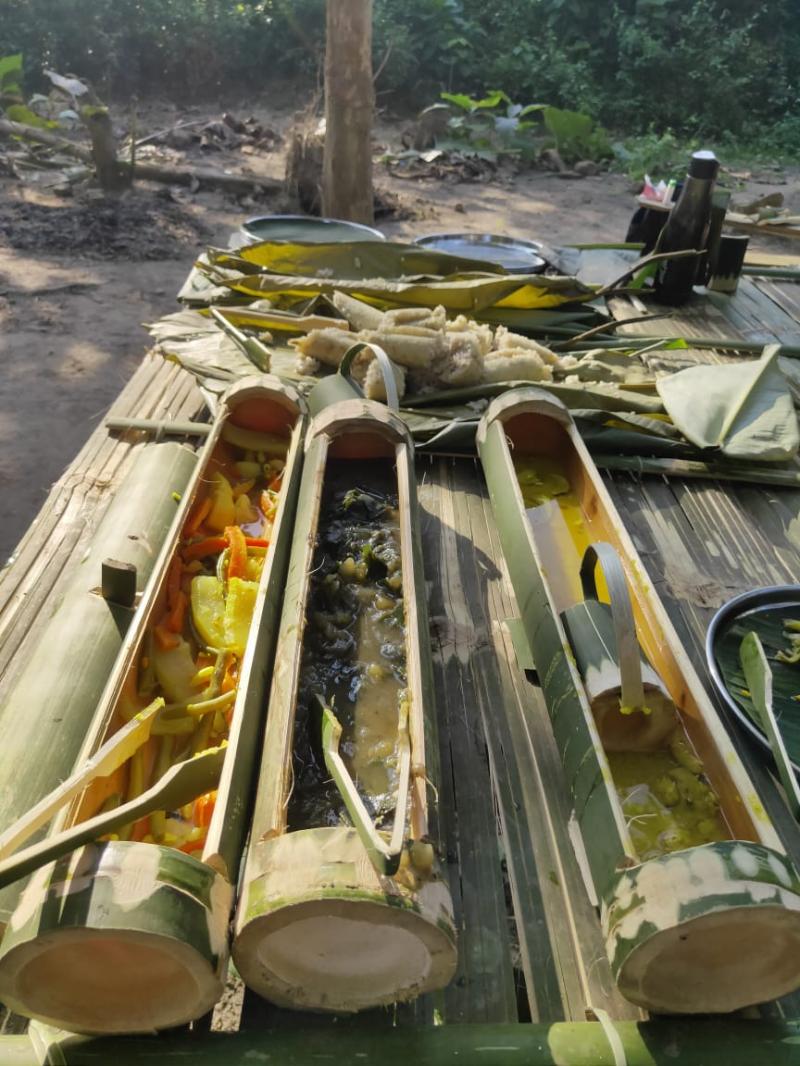
Traditional Karbi cuisine offered to guests during Ingnam Kengkam, Photo- Tonoy Protim Neog
Karan Sing Mochasari and Phulmoti Mosahari, a couple in Borgaon village have the experience of hosting a group of students from Bhupal and Gangtok.
For these villagers hosting guests from other communities who do not have familiarities in language and culture are unique experiences.
“We expect more such guests who have special interest in study and research and curious to learn our culture,” Karan Sing Mochasari says.
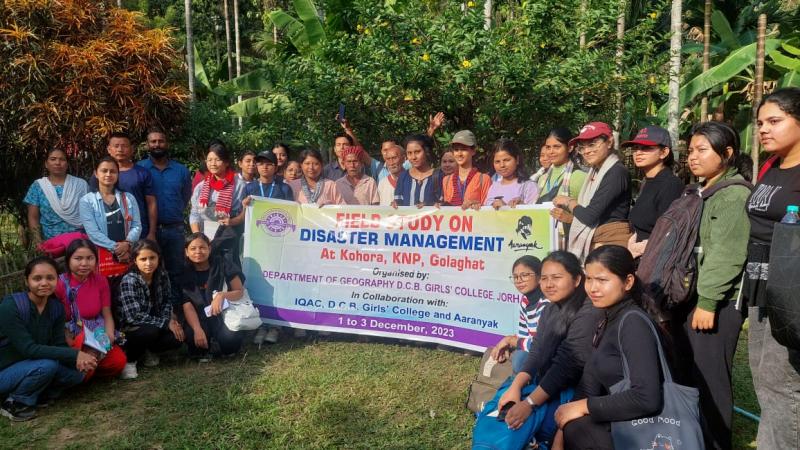
Homestay facilities have attracked students of Devi Chran Baruah Girl's College, Jorhat to enjoy educational field-trips, Photo- Juri Baruah
In Bhuyanpara range, Aaranyak helped the owners by providing financial assistance for construction of toilet and overhead tank for running water facility for the comfort of guests in addition to guidance in other aspects of eco-tourism. They are still awaiting government assistance and schemes to develop homestay.
“The objectives of such homestays include developing the facilities for eco-cultural tourism and also to develop alternative avenues of income to the people. The area of focus to develop such homestays are forest fringe villages of Manas National Park landscape and Kaziranga-Karbi Anglong National Park landscape,” says Jayanta Kumar Sarma, Senior Programme Associate of Natural Resource Management Programme.
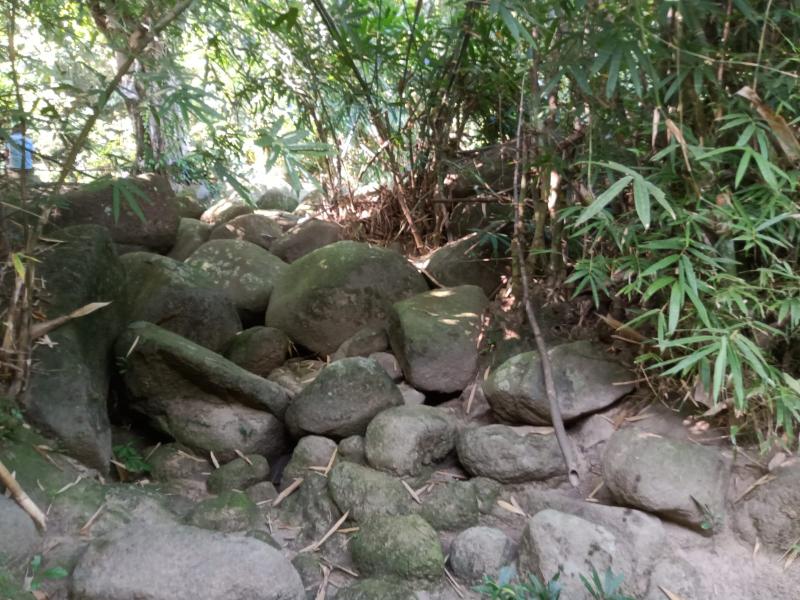
The gurgling sound of underground Langkiri river is a major attraction of Ingnam Kengkam journey,
Photo-Sushanta Talukdar
In Kohora basin of Karbi Anglong, homestays initiated by indigenous Karbi people have transformed into an innovative eco-tourism model in partnership with Aaranyak. It combines understanding of nature and traditional knowledge system of the Karbis with trekking and other forms of nature tourism.
Sarma says that they have come up with the unique concept of ‘Journey for Learning’, shortly ‘J for L’ which is kind of an exploration to the unseen interior of vast nature of the landscape. The ‘J for L’ has various modules including (a) extensive academic module or research based education tour for two weeks or more; (b) short term study tour which is open for all; (c) immersive experience learning that gives one the opportunity to live, cook and eat with the community people and learn about their life and livelihoods, agriculture, biodiversity and wildlife; (d) Ingnam Kengkam or ‘Walking in the forest’ Ideal for a group of around ten members, targeting those tourists who are on a tight schedule but want to have a locally guided experience of walking through the forests of the Karbi hills near Kaziranga National Park. This trek tour is guided by community people and subject experts. A non-veg meal cooked and smoked in bamboo mostly with wild leafy vegetables and herbs in unique Karbi style is part of Ingnam Kengkam.
There are separate Self Help Groups for homestay facilities and for “J for L” programme.
“Developing homestays is a new concept for us. Our guests are special, they are not merely tourists. They visit our places to learn something. We try to provide them the best service of stay and food. It also helps economically,” says Larbin Timungpi of Bakring Engti Village in Karbi Anglong and owner of homestay.
However, the depilated road condition and mobile network coverage are issues they face as hurdles to develop such facilities, she adds.
In all three locations of Manas and Kaziranga-Karbi Anglong landscapes, the homestay owners provide low-cost cozy accommodation, and offer home-made food. The accommodation per person rate per night is Rs.500/.
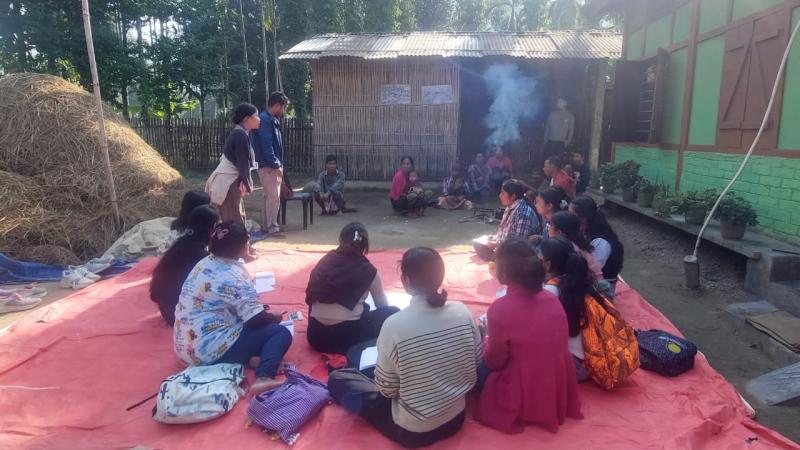
Sudents of Devi Charan Baruah Girl's College during an exchange with villagers, Photo- Juri Baruah
“The best experience from the Journey for Learning Program is the in-depth understanding of the indigenous knowledge system of the local tribes. Two field visits under this program of Aaranyak in the fringe villages of Manas National Park and Kaziranga National Park enriched our students on the issues related to how to conduct fieldwork and how to learn from the community. The face-to-face interaction with communities like Bodos and Karbis helped to highlight the core gaps in conducting research and analysing the necessary solutions regarding several issues such as forest conservation, sustainable livelihoods, tribal land rights, and the resistance of the communities’, says Juri Baruah, Assistant Professor, Department of Geography, Devi Charan Baruah Girl’s College, Jorhat.
She loves to lead student teams to these areas availing homestays as part of college field- trip. Baruah says these field experiences revealed that the communities residing in the buffer of the protected forests have certain forest classifications that are tied with their culture and eco-system.
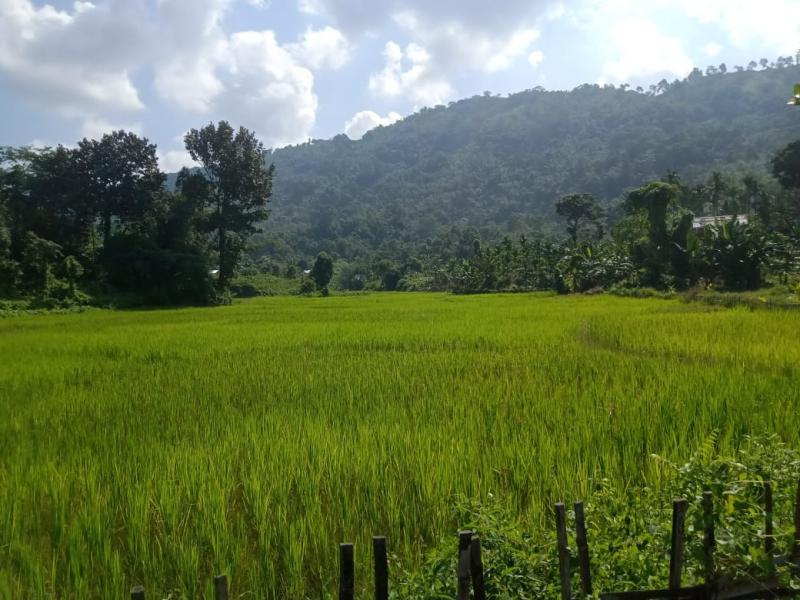
Photo--Sushanta Talukdar
“These unique landscapes can be termed as vernacular geography that are now under the pressure of conservation politics, developmental projects, natural disasters, and forest bureaucracy. Journey for Learning is therefore a bridge to communicating the grassroots and the grey areas of policy making”, she adds.
So far Aaranyak has been instrumental in developing four homestays with an accommodation capacity of 25 persons per night in Bhuyapara Range of Manas National Park landscape, 11 in Kohora basin of Kaziranga-Karbi-Anlong Landscape with an accommodation capacity of 35 per night and 18 in Angrajuli village in Bhairabkunda with an accommodation facility of 26 persons per night.
"Through its Journey for Learning programme, Aaranyak focuses on experiential learning on nature and culture; targeted to younger people and brings guest to these areas for the module based filed learning” Sarma adds
For some homestays in Manas landscape, apart from technical guidance and mentoring, Aaranyak has also provided financial support to develop toilet, bathroom and water system. Exposure visits of homestay owners facilitated by Aaranyak from Manas landscape to Kaziranga Karbi Anglong landscape and vice versa helped them share and learn from their experiences to fill the gaps.